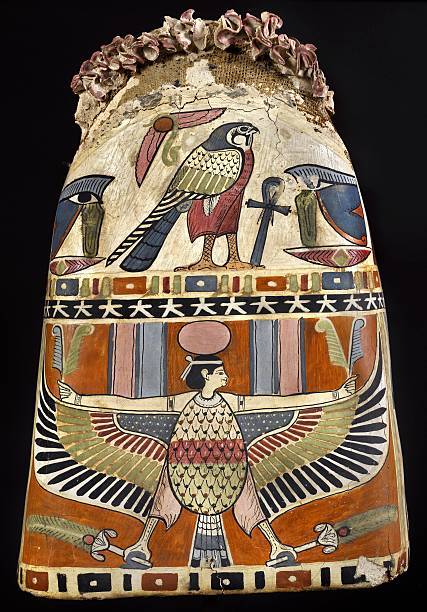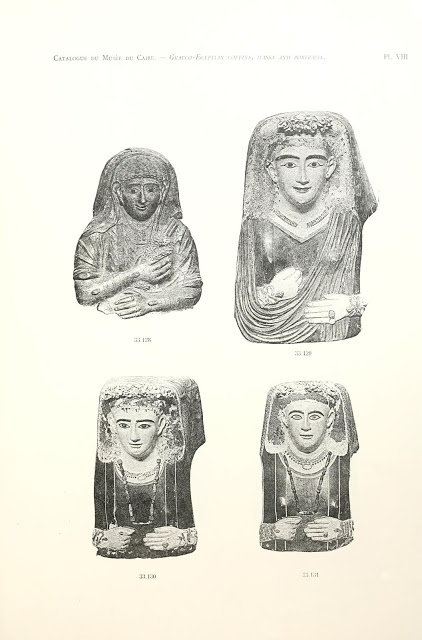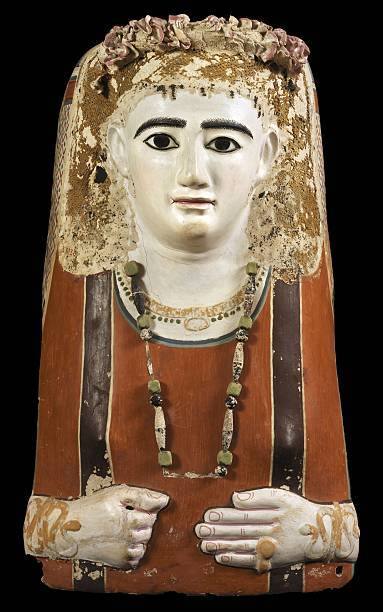
Provenance: Nazali Ganoub near Meir (Middle Egypt)
Entered the Cairo Museum in 1888 – CG 33130
This time, we will have a modern fashion in old Egypt. An Alexandrian/Roman pose from AD. It has its fineness for sure, but I may like the ancient masks a little more. Here I’d like to present another brilliant description by the wonderful Lady, Marie Grillot.
With the Macedonian dynasty of Alexander the Great, with the Lagids and their retinue of Ptolemies and Cleopatra, with the Roman emperors, Egypt became the “receptacle” of new populations … If they assimilated well to the country, they did not fail to import a new way of life, as well as traditions and customs …
Daily life, and of course culture and the arts, were impacted. This is felt on an important scale in architecture but also in a more “intimate” way in this perpetual quest for eternity which is reflected in particular in funeral rituals …
In “Ta Set Neferou” (volume 5), Christian Leblanc gives us his interesting reading: “What strikes the mind when we arrive precisely at this late period, it is this necessary need, not to say this will, of wanting to preserve the essence of Egyptian thought, as if one sensed its imminent disappearance “. And he adds: “For its part, the concept of immortality, which has lost none of its vitality, is perpetuated and the ‘Osirian becoming’ no longer affects only the elites of society. Now, as a kind of ‘ democratization ‘, any individual can claim an eternal life “…
If the new “masters” of the country have “adhered”, as a whole, to the practices of mummification, they have also modified certain aspects, adapting them to their own aesthetic canons.

Provenance: Nazali Ganoub near Meir (Middle Egypt)
Entered the Cairo Museum in 1888 – CG 33130
Thus, after the sobriety and meditation of the masks of mummies or sarcophagi from the “pharaonic” period, we are faced with new representations of the deceased.
If the so-called Fayoum portraits fascinate us with their deep gaze and their presence sublimated by a true pictorial technique, we do not fail to be surprised by this type of mummy mask …

Provenance: Nazali Ganoub near Meir (Middle Egypt)
Entered the Cairo Museum in 1888 – CG 33130
Posted here in “Graeco-Egyptian coffins, masks and portraits” by C.C. Edgar
Eugène Grébaut expresses it very well as follows: “We know how much, from the first century before our era, the decoration of coffins and mummies changed under the influence of Alexandrian taste. While at Fayoum the traditional mask was replaced by a portrait, painted in wax on a wooden panel that was fixed above the place where the mummy’s head was located, elsewhere the use of relief was retained, but the Osirian representation of the dead his bust dressed in the ceremonial habit “.
Dated from the 2nd century AD, this female mummy mask is 52 cm high, 34 cm wide and, with its backsplash, 44 cm deep.
It is in canvas and painted plaster and its design is of a very particular style, as Mohamed Saleh and Hourig Sourouzian (Official Catalog Egyptian Museum of Cairo) translate: “The technique is curious. The whole portion as the head one or more layers of coarse cloth stretched over a light wooden frame, built in such a way as to generally represent the shape of the upper half of the mummy. A thin layer of fine plaster or earth was covered with whitewash. Two mediocre protrusions, raised symmetrically, simulated the breasts of women in a more than summary fashion, but the parts of the body which are usually uncovered. Hands and face were executed with real care. They were prepared separately and applied to the desired location, the left hand stretched out on the hollow of the chest, the right hand closed, a little above of the left hand; we gave the mask the resemblance of the living as much as possible, and, after having fixed it firmly in its place, we applied around it the accessories of hairdressing, toiletry, or crown that the model included.

Provenance: Nazali Ganoub near Meir (Middle Egypt)
Entered the Cairo Museum in 1888 – CG 33130
Even if the expression of this portrait is difficult to qualify. There is no note of sadness in the gaze, nor the feeling of questioning relating to an unknown beyond.
Her face is a smooth milky white with some traces of pink on her cheeks. “The eyes are of rather complicated construction. The globe is decorated with a line of a dark reddish-brown, which shows the free edge of the eyelids; beyond, the eyelid itself is thickened with broadband. Of a slate blue turning to black, and which simulates the ordinary kohol band. The cornea is a clear white; the pupil comes out in black red on the iris of a dark red-brown. The eyebrow is accentuated by three lines of a blue-black, two on the outside which specify the curvature, one in the middle which follows the ridge of the brow bone “analyzes Gaston Maspero with precision.
The eyebrows are thick, materialized by a wide black line and treated as if they were “brushed” with small crisscrossing strokes.
The nose is ordinary and the mouth is small. The thin lips are “made up” in pink and the corners show a curious fold of expression. The ears are well-drawn. As for the hairstyle, it suffered and fell apart… The hair, which hangs down on each side of the neck, was composed of vegetable fibre, painted black. There is a crown on the top of the head, made of thin twisted pieces of plaster (like rose petals) attached to a roll-shaped ledge, and tinted pink on top “(Edgar Campbell Cowan, Graeco-Egyptian coffins, masks and portraits).
The throat is adorned with two necklaces. The first is a two-row choker while the second is long and goes down between the breasts. It is made up of various round and elongated pearls of different colours, punctuated with green squares.
At the bottom of her garment, a red chiton decorated with black bands, are plated her two hands. The folds of the fingers and the outline of the nails are painted red. A snake-shaped bracelet is wrapped around each wrist. The left little finger and ring finger wear a ring. The jewellery is painted yellow to restore the appearance of gold.

Provenance: Nazali Ganoub near Meir (Middle Egypt)
Entered the Cairo Museum in 1888 – CG 33130
Posted here in “Graeco-Egyptian coffins, masks and portraits” by C.C. Edgar
https://archive.org/details/graecoegyptianco00edga/page/n183/mode/2upMasque d’une momie de femme – toile, plâtre peint Epoque romaine – IIe siècle après J.-C. Provenance : Nazali Ganoub près de
Meir (Moyenne-Egypte) Entré au Musée du Caire en 1888 – CG 33130
What remained purely Egyptian, specify Mohamed Saleh and Hourig Sourouzian: “It is the decoration of the ‘cushion’ which supports the mask and encloses the head of the mummy. We see there protective deities such as Osiris, Isis and Horus, Anubis, Sokar and Nephthys and at the head, a falcon with outstretched wings “…
The provenance indicated for this mask from the Roman period is Nazali Ganoub, which is located about twenty kilometres from the necropolis of Meir, on the west bank of the Nile, in Middle Egypt. In “The Beautiful Burial in Roman Egypt: Art, Identity, and Funerary Religion”, Christina Riggs brings us these precious indications: “The site is especially known to Egyptologists for its tombs from the Old and Middle Kingdom, decorated in a lively way, carved into the stone escarpment that rises steeply from the desert plateau. Parts of the Meir necropolis continued to be used in Roman times, and between 1888 and 1914 several masks and mummies there were discovered. During the year 1888, ten mummy masks were sent from the nearest station, Nazali Ganoub, to the Egyptian Museum in Cairo, which was then located in Boulaq “.
No more precise indication is given on the place of the discovery, nor the identity of the deceased … This mask was registered in the General Catalog of the Cairo Museum under the reference CG 33130.
Sources:
Ta Set Neferou “(volume 5), Preface-introduction by Christian Leblanc – Authors: André Macke, Christiane Macke-Ribet and Jacques Connan, Ed. Dar Namatallah Press, Cairo, 2002 The Egyptian Museum. Collection of monuments and notes on excavations in Egypt, Eugène Grébaut, 1890-1907 http://gallica.bnf.fr/ark:/12148/bpt6k5808100r/f35.item.r=MASQUE
The Egyptian Museum – Collection of monuments and notes on excavations in Egypt, Ministry of Public Works, Gaston Maspero https://scholarship.rice.edu/jsp/xml/1911/9294/701/MusEgyp.tei-timea.html
Official catalogue Egyptian Museum of Cairo, Mohamed Saleh, Hourig Sourouzian, Verlag Philippe von Zabern, 1997 Graeco-Egyptian coffins, masks and portraits, Edgar, CC (Campbell Cowan), Egypt. Maslahat al-Athar, 1905, French Institute of Oriental Archeology https://archive.org/stream/graecoegyptianco00edga/graecoegyptianco00edga_djvu.txt
The Beautiful Burial in Roman Egypt: Art, Identity, and Funerary Religion, Christina Riggs https://books.google.fr/books?id=5pLX9rLqelQC&pg=PA110&lpg=PA110&dq=Meir%2C%20Nazali%20Ganoub&source=bl&ots=RVwZsXPpYt&sig=ACfU3U2801t5sajfmaH4y8aGu35VmsfPiQ&hl=fr&sa=X&ved=2ahUKEwiJg6KnxpvtAhUO2BoKHZpWB1QQ6AEwAHoECBAQAg&fbclid=IwAR3ik0x979L4iLGMS0Uq0mo1umwmAB__GDkxqTbUQXOZdkmFRLhVI2NxDTQ#v=onepage&q=Meir%2C%20Nazali%20Ganoub&f=false
So obviously influenced by the Greeks…
LikeLiked by 1 person
Oh yes, they were dominant at that time in every corner! 😉🙏
LikeLiked by 1 person
Amazing that the detail has survived on the masks. Fascinating post!
LikeLiked by 1 person
Thank you, my dear Chris, for your kind and inspiring comment. 🙏💖
LikeLiked by 1 person
Only a pleasure 🙂
LikeLiked by 1 person
So fascinating!!!
LikeLiked by 1 person
Grazie, mia cara Amica 🙏💖💖🤗😘
LikeLiked by 1 person
This is so cool and interesting! Thank you for sharing!
LikeLiked by 1 person
Thank a lot, my dear Michelle, that is indeed. 🙏💖💖
LikeLiked by 1 person
This is wonderful ! I love the art and your narrative! 💖
LikeLiked by 1 person
Thank you my lovely Holly 🙏❤
LikeLike
It was my pleasure, lovely post! 🙏❤
LikeLiked by 1 person
🙏🥰❤
LikeLiked by 1 person
❤️🤗
LikeLiked by 1 person
Interesting and strange to see the similarities with ancient images with such huge differences–beginning with skin color. I’ve seen other images from 2nd Century AD, but nothing similar to this. Blessed Equinox and New Year.
LikeLiked by 1 person
Thank you, dearest Elaine, yes, the colours are amazing. Have a wonderful Sunday my dear friend 🙏❤
LikeLike
Happy Persian new year dear.❤️
LikeLiked by 1 person
The same to you my dear friend 😘
سال نو تان شاد و پیروز❤
LikeLiked by 1 person
🙏💝
LikeLiked by 1 person